AMERICAN SAMOA
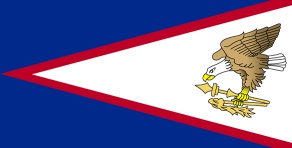
The Samoas – American Samoa and Western Samoa – are believed to have been inhabited since around 1000 B.C. when Protopolynesians first established themselves in the islands. These dates indicate that the Samoas were the first Polynesian society in the Pacific. The descendants of those early Polynesians – today’s Samoans – are also among the few remaining Polynesian societies.
The Samoans first became known to the Western world in 1722 when the Dutch navigator, Jacob Roggeveen, sighted three of the Samoan islands. However, he miscalculated their position, and they were not seen again for another 46 years until the French navigator, Bouganville, ‘refound’ the islands in 1768.
The division between the Samoas – American Samoa and Western Samoa – is a political division of recent years. The Samoas were the subject of many years of political struggle between Germany, Britain, and the United States. Eventually the islands were partitioned into Western (German) Samoa and Eastern (American) Samoa as the British withdrew their claims.
American Samoa has been a possession of the United States since 1900, and as such, it is the only U.S. soil south of the equator. The U.S. operated a coaling station and naval base in Pago Pago until World War II, and the islands were a U.S. Marine staging area during the war. However, there is little U.S. government presence today. In 1960, American Samoa ratified its territorial constitution, and it has since developed a modern, self-governing political system.
American Samoa consists of five volcanic islands and two coral atolls. It includes the eastern islands of Tutuila, Aunu’u, and Rose; three islands (Ta’u, Olosega, and Ofu) of the Manu’a group; and Swains Island. The total land area of these islands/atolls is only 76 square miles. Over 96% of the land in American Samoa is owned communally, and its use is regulated by traditional Samoan custom.
The main island of American Samoa is Tutuila located at 14ºS 170ºW. It is about 17 miles long in an ENE-WSW direction and 5 miles wide. The main port/town in American Samoa, Pago Pago, is located in the center of Tutuila. Pago Pago Harbor, where we anchored, is a collapsed volcano caldera.
The people of American Samoa – approximately 60,000 – are U.S. nationals, not U.S. citizens. However, many become naturalized U.S. citizens. America Samoa does 80-90% of its foreign trade with the U.S. with canned tuna being its primary export.
The Samoan social structure continues to be based on the extended family, and the Samoans cling tightly to their traditions. However, the influence of missionaries is also noticeably present in the islands. Activities other than church are highly discouraged on Sunday – a day when all businesses are closed. The influence of the missionaries is also present in the clothing worn by Samoans. Their dress is highly modest – especially for such a warm climate. Men wear long pants or lava-lavas, and women wear long skirts and cover their shoulders. It is common to see men in business suit jackets wearing a lava-lava rather than pants. Even the police uniforms are lava-lavas.
Our visit to American Samoa was one of purpose rather than just pleasure. We had been eating our stores for five months, and we needed to reprovision. We needed to brew a batch of beer. Also, we had not received mail in five months, and we wanted to catch up with that. We had a few business chores to tend to, and America Samoa offered some links to the U.S. that we will not see again as we head further west. So we went there with a long list of ‘to-dos’. But it was not all-work-and-no-play. We took the time to see much of the island of Tutuila, and we liked what we saw.
American Samoa was not what we expected. We were both pleasantly surprised and disappointed. First, the few disappointments, then the many pleasant surprises…
Our biggest disappointment was not a surprise, but we were quite uncomfortable with the fouled bottom in the anchorage. We rely on our anchor to hold both our boat and ourselves, and it is difficult to trust the security of your anchor in this fouled anchorage. Most of the boats drag some at some time, and knowing that caused us great concern whenever we left the boat. Dredging this part of the anchorage would be a huge service to visiting boats.
Our second disappointment with American Samoa was substantially less serious than dragging anchors, but a disappointment nonetheless. We were told that there was a Costco, and there was not. There is a Cost-U-Less, which is a warehouse store, but it is nothing like Costco. We were pleased to find many American goods with which we are familiar, but we could not find near as many as we had hoped. However, we are as close to Sydney, Australia as we are to Honolulu, Hawaii, so maybe it is time to let go of our reliance on familiar U.S. goods. We’re not in Kansas anymore, Toto.

Pago Pago Harbor
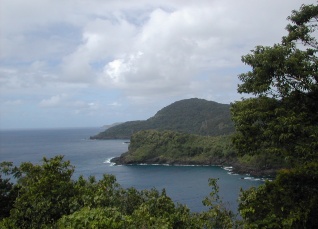
Pretty bay after pretty bay
But we had many more pleasant surprises than disappointments, and our most pleasant surprise was the people. Our interactions with the local population have all been positive. An example of the friendliness of the locals… We had run out of dark chocolate (not a small issue), and we asked around if/where we could find some. We asked the manager of an office supply when we stopped in for something else. She did not know where we could find any, but when we returned to the office supply a week later, she remembered us and gave us some dark chocolates that she had brought in “hoping we would return”. Even the government officials were consistently pleasant and helpful.
Another surprise was the cleanliness and beauty of the island. In the past, many boaters have reported the harbor to be intolerably filthy and polluted by the outflow from the canneries. That is largely cleaned up. The cannery outflow is pumped out a few miles offshore, and there is no noticeable inflow from the canneries. Yes, it is still quite fragrant when the wind blows just wrong, but the prevailing winds usually keep the odors away from the small boat anchorage.
And when you travel outside the town of Pago Pago, it is a beautiful island. We shared a two-day car rental with our friends, Don & Gwen on Tackless II, and we drove all over the island. The coastline is consistently beautiful with bays all around the island, and small villages dot many of the bays. There is also rather dramatic terrain along much of the shoreline. (We have visited only atolls since leaving Hawaii, and this is the first volcanic island we have visited. We forgot how spectacular the terrain can be!)
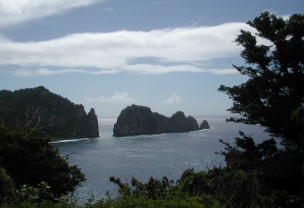
Dramatic terrain

As we drove through individual villages, we were impressed by the large number of churches, fales (meeting houses), and graves. Each village had at least one church and fale, and most villages had many. In one village, it seemed that each house had a fale in front of it. And there are family burial sites in front of most houses. Some are more elaborate than others, but it appears that most families bury their dead in front of their houses.
Although a rental car enabled us to see many miles of the island in a few days time, it is simple and inexpensive to get around without a car. There is a bus system that is efficient, colorful, and very user-friendly. Each bus is privately owned, and each is a reflection of its owner. Each bus has a unique paint job on its outside, but the real personality emerges on the dash and area surrounding the driver. Think of how some people personalize their work space with pictures, trinkets, and memorabilia. Add feather boas, artificial flowers, and loud music, and you can imagine one of the more sedate busses. They were wonderful! And we never paid a fare over $1.
We also had the opportunity to witness a few traditional cultural moments. One was fire dancing, and the other was traditional tattooing. The fire dancers perform traditional dances while handling burning torches. It’s quite a sight. And the traditional tattooing looks painful. Rather than using an electrical instrument, the tattooist dips a shark’s tooth in ink. The tooth is tied to a small stick, and the tattooist uses a second small stick to tap the shark’s tooth hard enough to break the skin. When large tattoos are done, it is not uncommon to work on someone eight hours per day for four or five days. Ouch!
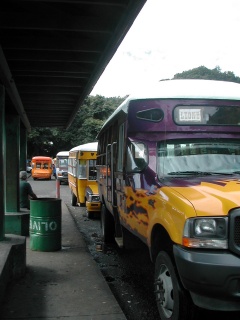
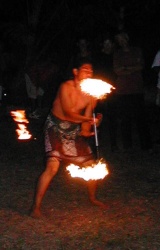
Fire dancer
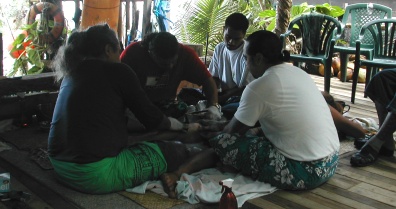
Day 3 of this traditional tattoo
We accomplished the chores on the ‘must-do’ list. We got a lot of food on board. We brewed and kegged 5 gallons of pale ale. We enjoyed interactions with the local population. And we saw many parts of a very pretty island. This was a good stop, but we were ready to move on.
Read about our sail to Western Samoa or jump ahead to our Samoa page.